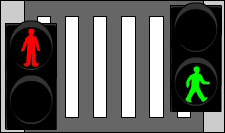Pelican Crossings
Created | Updated May 27, 2005

Pelican crossings are one of the most common types of traffic light-controlled pedestrian interfaces used in the UK and Ireland. Road traffic is controlled by the usual coloured lights. Foot crossing is controlled by red man/green man signal lights, which forbid or permit crossing of the road.
The name derives from a cute pseudo-acronym for 'Pedestrian Light Controlled', with the 'o' changed to an 'a' in deference to the bird. The use of improbable animal symbols began in 1951 with the introduction of 'zebra' crossings, which were made internationally famous by the Beatles and their Abbey Road album.
The Pelican process is started by a pedestrian pushing a button on one of the lighting posts to indicate their intention of crossing the road. After a period of time the traffic signal changes from 'green to amber to red' and stops the traffic. At this point the 'green man' signal is lit, indicating to waiting pedestrians that it is safe to cross. Once this sign has been illuminated for a certain period of time - doubtless calculated using some complex formula concerning the width of the road, average speed of the standard pedestrian etc - the 'green man' sign flashes to inform anyone currently crossing the road that the time remaining is running out. Those who have not already started to cross should now wait as only a few seconds remain before road traffic will be shown the green light and permitted to proceed.
However, as an added twist, once the green light starts to flash, the amber traffic light also flashes. This indicates to road users that they may proceed over the crossing without waiting for the green light, provided that the crossing is free of pedestrians.
This permits the following dangerous situation to occur: A vehicle approaches the crossing and prepares to stop because the lights are red, although at this point the crossing may be clear. The amber traffic light starts to flash and the driver accelerates to pass the empty crossing. At this point a pedestrian - seeing that the 'green man' signal is flashing, and knowing that this is set to give even the most infirm pedestrian time to finish crossing the road - leaps onto the crossing and is hit by the vehicle.
The blame for the accident in this case would fall on the pedestrian, who should not have started to cross once the green light had started to flash. It is interesting to note that newer types of British automated crossing such as the 'Toucan' (a joint pedestrian and bicycle crossing) have omitted the flashing amber phase altogether. They show the green traffic light only when the 'red man' is lit. Similarly, in many other European countries the signals controlling the pedestrian crossing change directly from 'go' to 'stop' without creating an intermediate phase. Such a phase can sometimes create a false sense of security amongst people with a tendency to thumb their noses at the rules.
An added level of safety was introduced with 'Puffin' crossings. These are similar to Pelican crossings in operation. However, the red and green men are situated on the traffic light post facing the pedestrian (above the 'Wait' panel), instead of on the opposite side of the road. 'Puffin' stands for 'Pedestrian User- Friendly Interface'. It is so named because of the microwave detector which alters the 'green man' period in accordance with the pedestrian crossing speed... This is considered to be a much better idea than separate Tortoise and Hare crossings.

